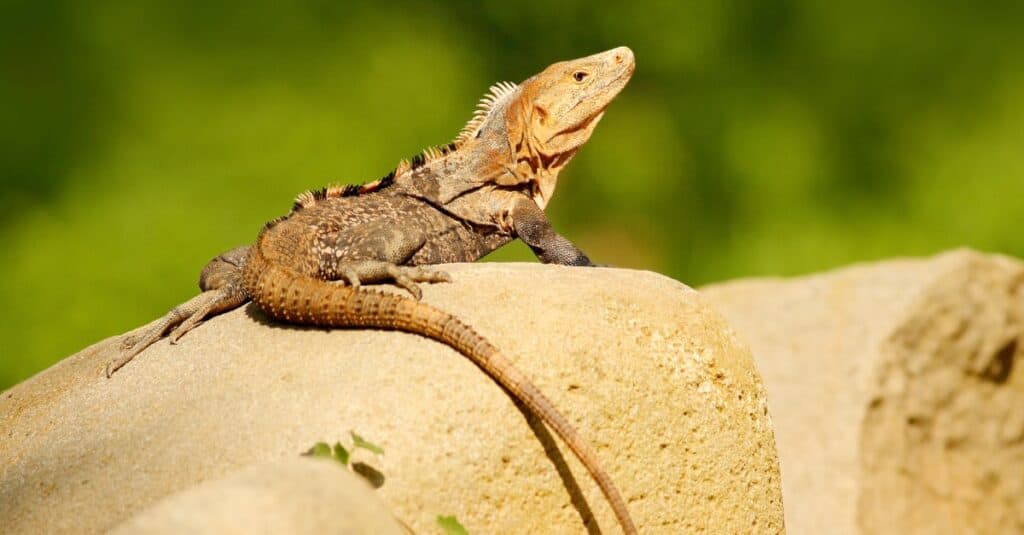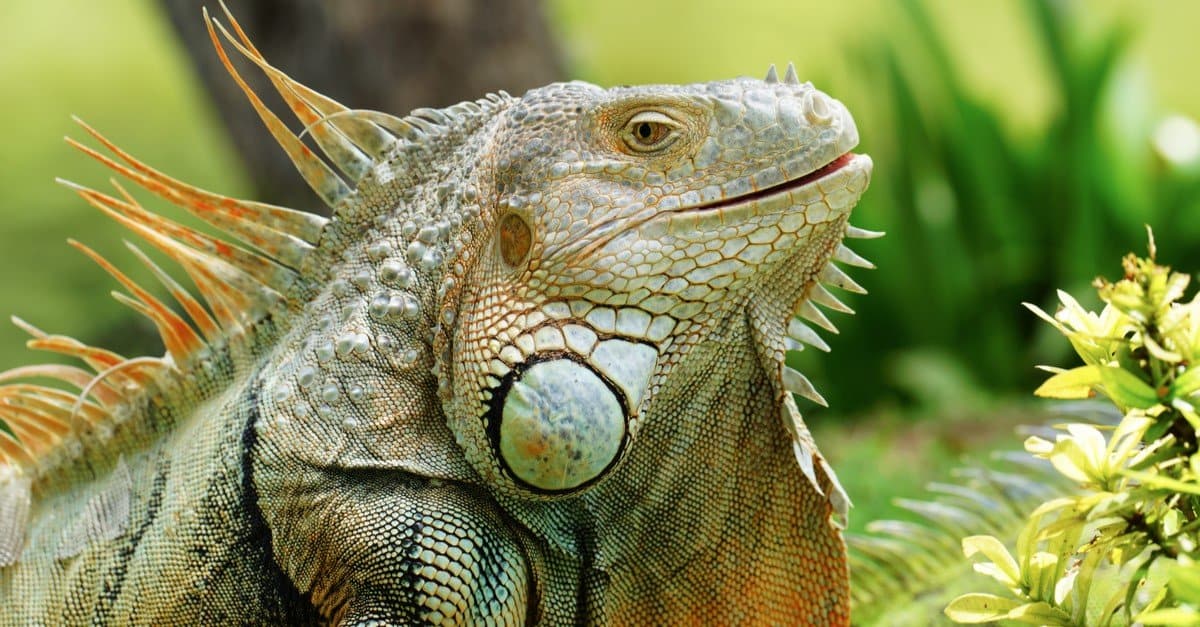A spectacular display is taking place in the lush vegetation and lively habitats of the United States’ sun-drenched southeastern regions. One particular species is supreme among the reptile aristocracy here: The formidable iguana! These prehistoric reptiles are renowned for their astounding size and unique adaptations. They hold the attention of both the casual viewer and the serious herpetologist alike. And the most interesting thing about them is that they aren’t native to the United States at all.
In this guide, we’ll take a look at the three biggest iguanas living in the United States today that have been introduced to the local wildlife by other countries. But first, let’s take a brief look at what iguanas actually are and why they are thriving in the United States.
What Are Iguanas?
These animals are amazing reptiles with unusual activities and appearances. They are a varied group of lizards that are mostly found in tropical and subtropical areas of the Americas and are members of the Iguanidae family. Due to their distinctive traits and adaptations, these reptiles have been able to pique the curiosity of both animal enthusiasts and scientists alike.
Classification
These reptiles are categorized as belonging to the Squamata order, which also includes lizards and snakes. They are a member of the Iguania suborder of this order, which also contains a number of other lizard families. These animals are further divided into the family Iguanidae, which has about 40 genera and over 700 species that are now recognized.
Common Species
The green iguana and the marine iguana are two of the most well-known iguanas. The big, herbivorous green iguana is a native of Central and South America. It has a long tail, powerful legs, and a crest of spines along its back. It also has a vivid green color as well. The only marine lizard in the world is the marine iguana. It is exclusive to the Galapagos Islands. It has evolved to live in water, where it mostly consumes seaweed and marine algae.
Habitat
Iguanas normally like environments with a balance of warmth, sunshine, and abundant vegetation. They are typically found in coastal areas, savannas, deserts, and rainforests. These lizards can climb quite well, and you may find them sunbathing on rocks or tree branches to maintain their body temperature. As seen by the marine iguanas, which have evolved to hunt for food underwater, they are also skilled swimmers.
Introduction to the United States
Despite being well-established in their natural environments, these animals are not indigenous to the United States. Nevertheless, they have spread across the nation, mostly as a result of the exotic pet trade. Particularly because of their distinctive look, green iguanas have been smuggled into the United States as pets. In other places with favorable conditions, including Florida and some areas of Texas, populations have grown as a result of the release or escape of some individuals.
Iguana populations that are not native to the United States have both beneficial and detrimental effects. On the plus side, these reptiles can increase biodiversity and pique the curiosity of enthusiasts. They can, however, also develop into invasive species that might disturb the ecosystem and compete with native fauna for resources. Populations of these non-native animals can grow quickly in places with favorable climates, causing problems for regional ecosystems.
Iguana populations that are not native to the United States are being managed and controlled, with an emphasis on humane techniques that put the well-being of the animals first. Campaigns for public education and awareness are also essential for stopping new releases and educating people about ethical pet keeping.
Are Iguanas Dangerous?
In general, these reptiles do not pose a threat to people. It is crucial to remember that their temperament and behavior might vary based on a number of variables, including their species, unique personalities, and degree of contact with people.
The majority of species are docile and mostly herbivorous. They usually rely on their speed and agility to get away from any threats since they like to avoid danger. They may engage in defensive actions including hissing or lashing their tails when attacked or cornered. These actions are often warning indications that should not be ignored because the animal feels threatened.
These reptiles generally represent little to no threat to people, but there are a few things that might make them potentially harmful. If they feel threatened and are unable to flee, large adult iguanas may inflict serious bites or scratches. If left untreated, their bites can result in severe damage and infection.
Just as well, some species like the green iguana have the capacity to reach size and strength that is quite impressive. Although they are mostly herbivorous, they may display territorial characteristics and try to protect themselves by biting or lashing out with their tail if they feel trapped or threatened.
Whether they are wild or kept as pets, these reptiles should always be treated with respect and caution. It is best to view them from a safe distance when they are in their natural environment and to avoid trying to handle or touch them.
1. Green Iguanas
Classification: Iguana iguana
The massive lizards called green iguanas are indigenous to the tropics of Central and South America. They are among the most well-known and often-kept iguana species. Green iguanas may grow to astonishing lengths of five to seven feet and weigh anything from 11 to 20 pounds as adults. In general, they are considered the largest iguana species living in the United States, particularly in Florida.
Although green iguanas are not native to the United States, they have been brought here and have developed colonies, mainly in southern Florida and certain areas of Texas. These regions offer the warm, tropical climate that these reptiles need to flourish. They will frequent gardens, parks, and residential areas where they make use of the lush flora for feeding and sunbathing. Concerns regarding their possible influence on nearby ecosystems have been raised by their presence in these non-native settings.

Green iguanas (pictured) are considered the largest iguanas that live in the wild in the U.S.
©iStock.com/passion4nature
2. Mexican Spiny-Tailed Iguanas
Classification: Ctenosaura pectinata
Mexican spiny-tailed iguanas are indigenous to Mexico and Central America. These reptiles are renowned for their enormous size. Adults may grow to be three to four feet long and weigh up to 10 pounds. They have a strong physique and recognizable spiky tails that give them their distinguishing look.
Mexican spiny-tailed iguanas were brought to some U.S. regions, especially through the exotic pet trade, even though they are not native to the United States. In areas with warm weather, such as parts of southern Florida and the Florida Keys, established populations can be found thriving.

Mexican spiny-tailed iguanas (pictured) are known for their notably spiky tails.
©iStock.com/Cezary Wojtkowski
3. Black Spiny-Tailed Iguanas
Classification: Ctenosaura similis
Black spiny-tailed iguanas are native to Central America, notably Belize, Honduras, Guatemala, and portions of Mexico. These reptiles are renowned for their strong constitutions, enormous sizes, and beautiful looks. Adults have a maximum height of three to four feet and a maximum weight of 10 pounds. They have a dark, black, or dark gray appearance, and their tails are heavily covered in spines.
The United States does not have any native black spiny-tailed iguanas. They have nonetheless been imported to several areas, mostly through the exotic pet trade, much like other iguana species. Particularly in Miami-Dade County in southern Florida, there are established populations of black spiny-tailed iguanas that can be seen today. These regions provide a warm, subtropical climate that supports their survival and reproduction.

The black spiny-tailed iguana (pictured) is very similar to the Mexican spiny-tailed iguana.
©iStock.com/Ondrej Prosicky
Summary of the 3 Biggest Iguanas in the U.S.
| # | Name | Classification |
|---|---|---|
| 1 | Green Iguana | Iguana iguana |
| 2 | Black Spiny-Tailed Iguana | Ctenosaura pectinata |
| 3 | Mexican Spiny-Tailed Iguana | Ctenosaura similis |
Thank you for reading! Have some feedback for us? Contact the AZ Animals editorial team.








